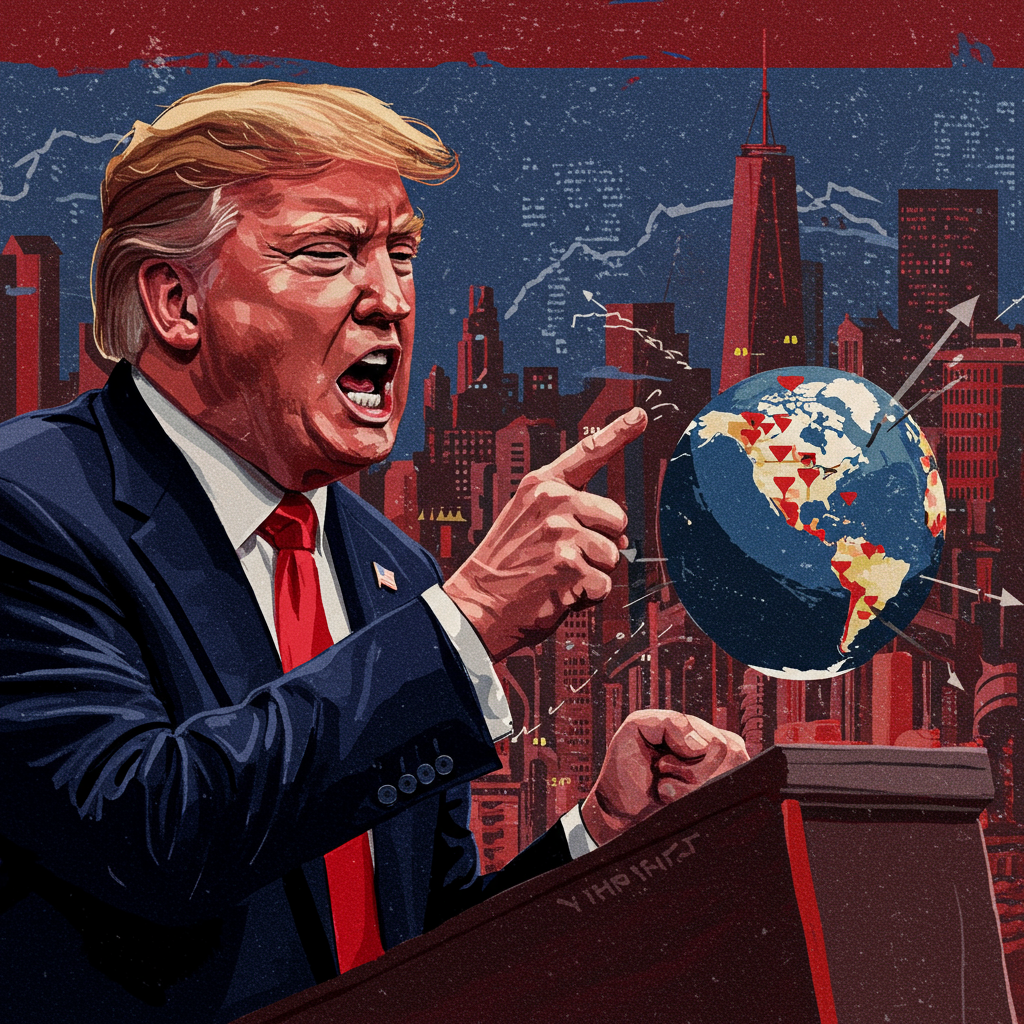Former President Donald Trump has issued a stark warning, threatening an additional 10% tariff on nations perceived as aligning with the policies of the brics economic bloc. This significant declaration arrived as the influential group convened its latest meeting, signaling potential new fronts in global trade tensions should Trump return to office.
The threat, announced via a social media post, did not specify which BRICS policies Trump deems “Anti-American.” However, coming amidst the BRICS summit, it underscores the growing economic and geopolitical rivalry between the United States and the expanding bloc of developing nations. The move echoes Trump’s previous use of tariffs as a key instrument of foreign and economic policy.
Unpacking Trump’s Tariff Threat
In a post on Truth Social, Trump stated clearly, “Any Country aligning themselves with the Anti-American policies of BRICS, will be charged an ADDITIONAL 10% Tariff. There will be no exceptions to this policy.” This directive suggests a potential shift towards punitive trade measures targeting countries based on their geopolitical alignment rather than specific trade practices alone. The vagueness of “Anti-American policies” leaves the criteria for facing these extra duties open to interpretation, creating uncertainty for nations navigating relations with both the U.S. and the BRICS group.
Experts suggest the timing and nature of Trump’s threat were likely a direct response to statements emerging from the BRICS meeting. Stephen Olson, a former U.S. trade negotiator, noted that the BRICS leaders’ joint declaration seemed to implicitly criticize Trump-era trade tactics.
BRICS Challenges Unilateralism
During their summit, BRICS leaders issued a joint statement that, while not explicitly naming the United States, warned against “unjustified unilateral protectionist measures, including the indiscriminate increase of reciprocal tariffs.” They voiced “serious concerns about the rise of unilateral tariff and non-tariff measures which distort trade and are inconsistent with WTO rules.” This collective stance highlights the bloc’s growing assertiveness on the global stage and its opposition to trade practices it views as disruptive and harmful to the global economy, particularly for developing nations. The BRICS leaders contended that the “proliferation of trade-restrictive actions” risks worsening existing economic disparities worldwide.
The BRICS group describes itself as a “political and diplomatic coordination forum for countries from the Global South.” Its membership includes Brazil, Russia, India, China, South Africa, Saudi Arabia, Egypt, United Arab Emirates, Ethiopia, Indonesia, and Iran. The bloc’s stated goals involve challenging traditional Western-dominated institutions of global economic governance and reducing the U.S. dollar’s central role in the global economy, according to analysis by the Carnegie Endowment for International Peace. This ambition to shift the global economic order could be precisely what Trump refers to as “Anti-American” policy alignment.
The Broader Context of Trump’s Tariff Strategy
Trump’s latest threat fits within a broader pattern of leveraging tariffs to pressure trading partners. This isn’t the first time he has used tariffs or threatened them on a large scale. In April, he announced steep tariffs on most trading partners but subsequently introduced a 90-day pause, initially set to expire on Wednesday following his latest statement. His administration confirmed that letters detailing country-specific tariff rates and any agreements reached would begin delivery shortly after his announcement.
Treasury Secretary Scott Bessent clarified earlier statements, indicating that tariffs announced in April would take effect on August 1st for countries that had not reached an agreement with the U.S., revising an earlier July 9th reference. Bessent described August 1st not as a new deadline, but rather as the definitive date the tariffs would commence for non-compliant nations, framing it as an opportunity for countries to either agree to terms or revert to previous rates. This fluctuating timeline and conditional implementation have contributed to uncertainty among investors and international trading partners.
International Reactions and Geopolitical Implications
China, a founding and prominent member of BRICS, quickly pushed back against Trump’s tariff threat. A spokesperson for the Chinese Foreign Ministry stated that China opposes using tariffs as a “tool to coerce others.” Speaking at a regular press briefing, the spokesperson reiterated China’s consistent stance against tariff wars and trade wars, arguing that “arbitrarily slapping tariffs does not serve the interests of any party.” This response aligns with the BRICS bloc’s general opposition to unilateral trade measures.
The BRICS group also used their recent meeting to offer symbolic support to fellow member Iran, issuing a condemnation of military strikes on the country. While the statement avoided naming specific nations responsible (like Israel or the U.S.), it highlighted the bloc’s willingness to address sensitive geopolitical issues and show solidarity among its members, further underscoring its role as a counterpoint to Western-led foreign policy.
The potential return of Trump’s aggressive tariff policies, particularly those explicitly linked to geopolitical alignment, raises significant questions about the future of global trade architecture. It suggests a move away from multilateral trade frameworks like the World Trade Organization (WTO), which the BRICS statement implied were being undermined by “inconsistent” unilateral measures. Such policies could force countries to choose sides between the U.S. and emerging blocs, potentially fragmenting the global economy along geopolitical lines. The economic impact could be far-reaching, affecting supply chains, consumer prices, and international investment flows. For countries heavily reliant on trade with both the U.S. and BRICS members, navigating this landscape could become increasingly challenging.
Frequently Asked Questions
What specific BRICS policies does Trump consider “Anti-American”?
Donald Trump’s social media post threatening tariffs did not specify the exact BRICS policies he deems “Anti-American.” However, experts like former U.S. trade negotiator Stephen Olson suggest this likely refers to the BRICS members’ expressed desire to move away from a U.S.-led global order, particularly in finance and governance. The BRICS bloc explicitly aims to challenge Western-dominated economic institutions and reduce the U.S. dollar’s global role, which could be the core of the “Anti-American” sentiment from Trump’s perspective.
Why did Trump announce these potential tariffs during the BRICS meeting?
The timing of Trump’s tariff threat strongly suggests it was a reaction to the BRICS summit and its outcomes. The BRICS leaders issued a joint statement criticizing “unjustified unilateral protectionist measures,” a clear, albeit indirect, jab at Trump’s signature tariff policies. Experts believe this collective criticism likely provoked Trump’s immediate response, framing the BRICS alignment as a challenge to American interests and threatening punitive trade actions in return.
What could be the economic impact of Trump’s proposed 10% tariffs on BRICS-aligned nations?
An additional 10% tariff, with “no exceptions,” could significantly increase the cost of goods imported into the U.S. from targeted nations, potentially harming businesses and consumers. For the countries facing these tariffs, it could reduce their export competitiveness in the U.S. market, impacting their economies. Such measures are seen by critics, including the BRICS bloc itself, as “unjustified unilateral protectionist measures” that “distort trade” and threaten to “disrupt the global economy,” potentially worsening existing economic disparities by adding new barriers to international commerce.
Conclusion
Donald Trump’s threat of an additional 10% tariff on countries aligning with “Anti-American” BRICS policies injects a new layer of uncertainty into global trade relations. Issued during the BRICS summit and following the bloc’s implicit criticism of unilateral tariffs, the threat signals a potential return to highly politicized trade measures should Trump assume the presidency again. While the specific criteria for facing these tariffs remain vague, the move underscores the growing geopolitical competition between the U.S. and the expanding BRICS bloc. The coming months will reveal how nations react to this pressure and what implications it holds for the global economic order and the future of international trade frameworks.


